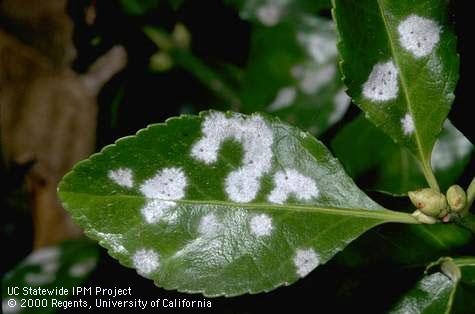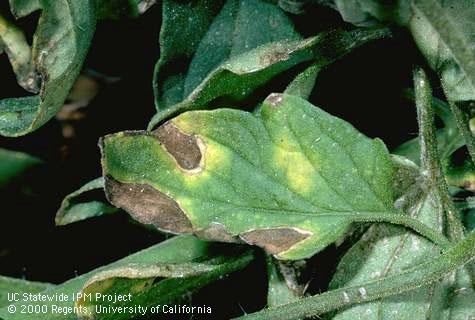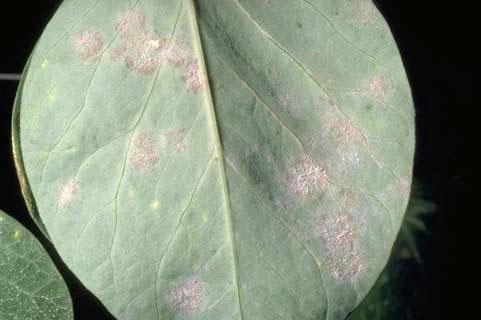
The fungi collectively known as powdery mildew are unusual in that they don't require moisture to establish an infection and grow. Similarly, unlike most fungi, powdery mildew fungi do well in warm weather, and so are common at this time of year when other fungi are less active.
Like all diseases, powdery mildew fungal infection occurs when the fungal pathogen contacts a suitable host and environmental conditions are favorable. Most prevention involves decoupling this disease triangle by changing environmental conditions to make them unfavorable for fungal growth and survival, by planting non-susceptible or resistant host plants or by controlling or removing the pathogen.
Signs and Symptoms: Powdery mildew fungi first appear as white powdery, cottony patches that form on the plant. White spots spread over a large area of the plant in the most susceptible species. Vegetables and other annuals are more often severely damaged, but woody plants like roses and sycamores can also suffer significant damaged. In vegetables, leaves infected with powdery mildew may turn yellow, die, and fall off, twist, buckle and become distorted. On woody plants, new growth may become distorted, dwarfed, and die back.
Lifecycle: Most species of powdery mildew fungi grow as thin layers of mycelia (fungal tissue) on the surface of the plant. Spores, which act as the dispersal unit for the fungi, create what we see as a white powdery growth that gives these fungi their common name. Powdery mildew spores are transported by wind (and humans) to other locations on the plant or nearby plants
Powdery mildew fungi require living tissue to grow. On perennial plants, powdery mildew survives in buds or on the bark of branches and stems. On vegetables and annuals, the fungi survive attached to plant parts and plant debris such as fallen leaves. Some species of powdery mildew fungi produce special resting spores; other reservoirs of infectious material include weed hosts that persist when the cultivated hosts die back. For example, the form of powdery mildew that infects barley (Hordeum vulgare) also infects related weeds in the genus, Hordeum.
Where: Powdery mildew fungi and the diseases they cause are prevalent in both inland and coastal areas of Del Norte and Humboldt Counties. The white patches associated with powdery mildew can be foundboth upper and lower surfaces of the leaves, on shoots and, in some cases, on flowers and fruit. Vegetables susceptible to powdery mildew fungi include artichoke, beans, beets, carrot, cucumber, eggplant, lettuce, melons, parsnips, peas, peppers, pumpkins, radicchio, radishes, squash, tomatillo, tomatoes, and turnips. On ornamentals and perennials, the fungi may infect old or new leaves. In some species, like roses, sycamores and crape myrtles, the fungi attack attacks new growth including buds, shoots, flowers, and leaves.
When: Although humidity requirements for germination vary among powdery mildew fungi, all species can germinate and infect their hosts in the absence of free water—an unusual trait among fungi. Indeed, standing water on plant surfaces inhibits germination and kills some species of powdery mildew fungi. Temperatures between 60-80° F and shady conditions favor disease development, extreme heat (>90°F) and direct sunlight, damage mycelia and spores.



Resources:
Powdery Mildew on Strawberries
Powdery Mildew on Field-Grown Tomatoes
Powdery Mildew on Greenhouse and Coastal Tomatoes
Links—not hyperlinked
Powdery Mildew Biology https://pnwhandbooks.org/plantdisease/pathogen-articles/common/fungi/powdery-mildew-diseases
Powdery Mildew on Vegetables: http://ipm.ucanr.edu/PMG/PESTNOTES/pn7406.html
Powdery Mildew on Ornamentals: http://ipm.ucanr.edu/PMG/PESTNOTES/pn7493.html
Powdery Mildew on Cucurbits: http://ipm.ucanr.edu/PMG/GARDEN/VEGES/DISEASES/cupowerymildew.html
Powdery Mildew on Grass: http://ipm.ucanr.edu/TOOLS/TURF/PESTS/dispowder.html
Powdery Mildew on Artichokes: https://www2.ipm.ucanr.edu/agriculture/artichoke/powdery-mildew/
Powdery Mildew on Apples: https://www2.ipm.ucanr.edu/agriculture/apple/Powdery-mildew/
Powdery Mildew on Apricot: https://www2.ipm.ucanr.edu/agriculture/apricot/Powdery-mildew/
Powdery Mildew on Caneberries: https://www2.ipm.ucanr.edu/agriculture/caneberries/powdery-mildew/
Powdery Mildew on Carrots: http://ipm.ucanr.edu/PMG/r102100111.html
Powdery Mildew on Cherry https://www2.ipm.ucanr.edu/agriculture/cherry/Powdery-Mildew/
Powdery Mildew on Grapes https://www2.ipm.ucanr.edu/agriculture/grape/Powdery-Mildew/
Powdery Mildew on Lettuce https://www2.ipm.ucanr.edu/agriculture/lettuce/Powdery-Mildew/
Powdery Mildew on Nectarines https://www2.ipm.ucanr.edu/agriculture/nectarine/powdery-mildew/
Powdery Mildew on Peaches https://www2.ipm.ucanr.edu/agriculture/peach/Powdery-mildew/
Powdery Mildew on Peppers http://ipm.ucanr.edu/PMG/r604100111.html
Powdery Mildew on Pistachio https://www2.ipm.ucanr.edu/agriculture/pistachio/Powdery-Mildew/
Powdery Mildew on Plum http://ipm.ucanr.edu/PMG/r611100711.html
Powdery Mildew on Strawberries https://www2.ipm.ucanr.edu/agriculture/strawberry/Powdery-mildew/
Powdery Mildew on Field-Grown Tomatoes https://www2.ipm.ucanr.edu/agriculture/tomato/Powdery-Mildew-on-Field-Grown-Tomatoes/
Powdery Mildew on Greenhouse and Coastal Tomatoes https://www2.ipm.ucanr.edu/agriculture/tomato/Powdery-Mildew-on-Greenhouse-and-Coastal-Tomatoes/
Images:
- D-SP-EPOL-FO.001-Caption Sugar pea foliage damaged by powdery mildew Erysiphe polygoni. A Charles Crabb UC IPM image Link: http://ipm.ucanr.edu/PMG/E/D-SP-EPOL-FO.001.html
- D-SP-EPOL-FR.001- Caption Brownish spots on pea pod from powdery mildew infection-A Charles Crabb UC IPM image Link http://ipm.ucanr.edu/PMG/E/D-SP-EPOL-FR.001.html
- D-TO-LTAU-FO.001- Caption Powdery mildew causes irregular yellow blotches on tomato leaves-Jack Kelly Clark UC IPM image Link http://ipm.ucanr.edu/PMG/L/D-TO-LTAU-FO.001.html
- D-WO-MEUO-FU.007- Caption White patches of powdery mildew on euonymus leaf-Jack Kelly Clark UC IPM image Link http://ipm.ucanr.edu/PMG/M/D-WO-MEUO-FU.007.html
- D-WO-SPAN-FO.001- Caption Powdery mildew, Sphaerotheca pannosa, on rose-Jack Kelly Clark UC IPM image Link http://ipm.ucanr.edu/PMG/S/D-WO-SPAN-FO.001.html